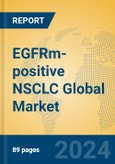The market is propelled by rising lung cancer prevalence, advancements in genomic profiling, and growing demand for personalized treatments, with innovations like next-generation TKIs and combination therapies reshaping its trajectory. It serves oncologists, healthcare providers, and patients seeking effective, mutation-specific solutions in a landscape increasingly defined by biomarker-driven care.
Market Size and Growth Forecast
The global EGFRm-positive NSCLC market is estimated to be valued between USD 4 billion and USD 5 billion in 2025, with a projected compound annual growth rate (CAGR) of 6% to 7.5% from 2025 to 2030, reaching approximately USD 5.6 billion to USD 7 billion by 2030. Growth is driven by increasing diagnosis rates and therapeutic advancements.Regional Analysis
- North America: Growing at 5-6%, the U.S. leads with advanced diagnostics and high adoption of targeted therapies, trending toward combination treatments and early screening.
- Europe: With a 5-6% growth rate, Germany, France, and the UK dominate, driven by strong healthcare systems and research, with precision medicine integration trending.
- Asia Pacific: Exhibiting a 7-9% growth rate, China, Japan, and South Korea excel, fueled by rising lung cancer incidence and healthcare investments, with affordable TKIs trending.
- Middle East and Africa (MEA): Growing at 4-5%, UAE and Saudi Arabia advance with improving oncology care, focusing on access to novel therapies.
- South America: With a 4-5% growth rate, Brazil leads with growing awareness and treatment access, emphasizing cost-effective options.
Product Type Analysis
- Afatinib: Expected at 5-6%, this second-generation TKI offers irreversible binding, with trends toward broader mutation coverage.
- Amivantamab: Projected at 6-8%, this bispecific antibody targets EGFR and MET, trending toward combination use in resistant cases.
- Dacomitinib: Expected at 5-6%, this second-generation TKI focuses on potency, with steady use in specific mutations.
- Others: Projected at 6-7%, emerging therapies like third-generation TKIs and novel agents grow, with innovation driving adoption.
Key Market Players
- AstraZeneca: A global leader delivering groundbreaking oncology solutions for targeted cancer care.
- Johnson & Johnson: A powerhouse innovating in bispecific antibodies for complex cancers.
- Takeda Pharmaceutical: A dynamic force advancing precision therapies for NSCLC patients.
- Blueprint Medicines Corp: A trailblazer in kinase inhibitors for mutation-driven cancers.
- Dizal Pharmaceutical: A rising star crafting novel treatments for Asian markets.
- Oric Pharmaceuticals: A creative pioneer in overcoming cancer resistance mechanisms.
- Black Diamond Therapeutics Inc.: An agile innovator targeting EGFR mutation landscapes.
- Taiho Pharmaceutical Co. Ltd.: A spirited provider of oncology breakthroughs for global reach.
- Boehringer Ingelheim: A robust player enhancing NSCLC treatment efficacy.
- Bayer AG: A versatile leader in oncology innovation and patient care.
- ArriVent Biopharma: An emerging force in precision oncology solutions.
Porter’s Five Forces Analysis
- Threat of New Entrants: Low, with high R&D costs, regulatory hurdles, and patent protections limiting entry.
- Threat of Substitutes: Medium, as chemotherapy and immunotherapy compete, but targeted therapies’ efficacy retains dominance.
- Bargaining Power of Buyers: Medium, with healthcare systems negotiating prices, patients less influential.
- Bargaining Power of Suppliers: Medium, with reliance on biotech inputs offset by large-scale sourcing.
- Competitive Rivalry: High, with firms battling over innovation, efficacy, and market share.
Market Opportunities and Challenges
Opportunities
- Rising lung cancer prevalence: Increasing NSCLC cases globally drive demand, amplifying the need for EGFR-targeted solutions.
- Genomic profiling advances: Enhanced diagnostics boost mutation detection, expanding the treatable patient pool.
- Personalized medicine growth: Demand for tailored therapies elevates market potential, targeting specific EGFR mutations.
- Combination therapy trends: Integrating TKIs with other agents enhances efficacy, opening new treatment avenues.
- Emerging market expansion: Growing healthcare access in Asia offers untapped potential, supported by cost-effective drugs.
Challenges
- High R&D costs: Developing novel therapies strains budgets, challenging smaller firms.
- Drug resistance: Emerging resistance to TKIs threatens efficacy, needing continuous innovation.
- Regulatory complexity: Stringent approval processes delay market entry, raising costs.
- Competitive alternatives: Immunotherapies and other targeted drugs vie for share, requiring differentiation.
- Access disparities: Limited healthcare infrastructure in some regions hampers adoption, needing outreach.
This product will be delivered within 1-3 business days.
Table of Contents
Companies Mentioned
- AstraZeneca
- Johnson & Johnson
- Takeda Pharmaceutical
- Blueprint Medicines Corp
- Dizal Pharmaceutical
- Oric Pharmaceuticals
- Black Diamond Therapeutics Inc.
- Taiho Pharmaceutical Co. Ltd.
- Boehringer Ingelheim
- Bayer AG
- ArriVent Biopharma








